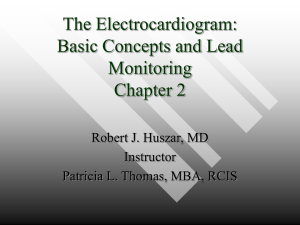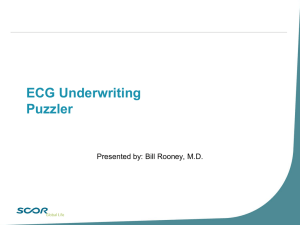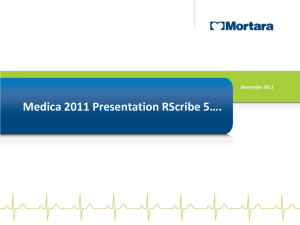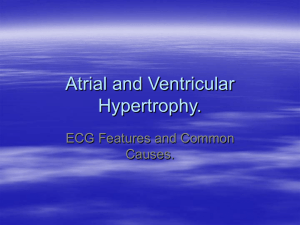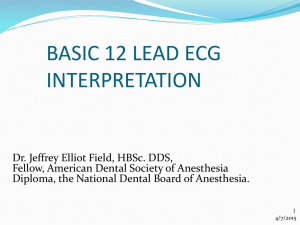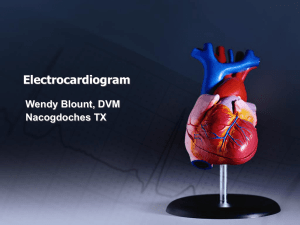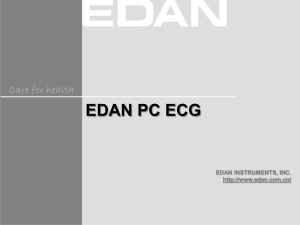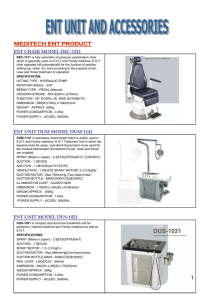File
advertisement
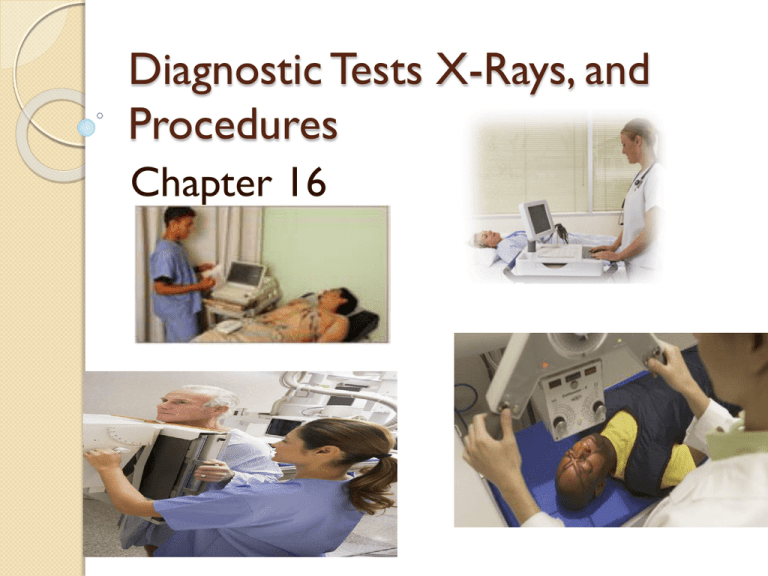
Diagnostic Tests X-Rays, and Procedures Chapter 16 Diagnostic Tests X-Rays, and Procedures The medical assistant has multiples roles in these tests You will be responsible for instructing and preparing patients for procurers, tests, and x-rays In some cases, you will either carry out the test(s) or procedures, or assist the health care provider Skin Tests These procedures are commonly used to determine allergic reactions in patients They are the scratch, intradermal, and patch tests These tests should always be performed under the supervision of a provider These tests involves introducing an antigen directly into the patient’s skin to induce a reaction If the reaction is negative, there will be no change in the appearance of the skin Skin Tests A positive allergic reaction to a test is shown by a raised area on the skin, much like a mosquito bite, called a wheal(hive) Skin Tests A positive reaction is caused by interaction of the antigen and antibody, which releases histamine and is termed a hypersensitive reaction Besides histamine, researchers are finding other chemicals released during the allergic response Many have allergies to a variety of substances, including certain foods, pollens, dust, drugs, chemicals, venom of stinging insects, animals, molds, and other allergens Certain irritants can make allergies worse These include smoke, gasoline, paint, perfumes, and personal grooming products(hair spray, soaps, lotions ect) Skin Tests Severe reactions can be life-threatening A life-threatening reaction must be counteracted with an injection of adrenalin immediately to prevent anaphylactic shock, symptoms include intense anxiety, weakness, sweating, and shortness of breath These might be followed by hypotension, shock, arrhythmia, respiratory congestion, laryngeal edema, nausea, and diarrhea Skin Tests Treatment for many allergy patients consist of an allergy immunotherapy program Over a considerable period, which can be indefinite, this therapy gradually provides immunization against the substance to which the person is allergic Increasing amounts of the allergen are injected as long as the patient can tolerate each dose Following the injection the patient must wait for 20 min for possible reaction You must keep a record of where the injection was administered and injection sites must be rotated Scratch Test/Skin Prick Test Sites for this test are the arms and the back The test should be numbered in a pattern with washable ink on the surface of the skin There will be some discomfort with this test(explain to the patient) Several applicators have been dipped into various bottles of allergens and applied to the skin with small drops, reactions usually occur within 20 minutes Have the patient report any reaction Many physician evaluate the patient after 24 hours Intradermal Test This test is thought to be more accurate, and is often performed if the scratch test is negative or unclear Severe reactions may occur with this test Intradermal test sites are performed at spaced intervals on the forearm or scapular area if the initial test is negative, it is often repeated with a stronger solution Usually the reaction time is 15 to 30 minutes Epinephrine should be kept on hand for any severe reaction(ordered by the physician) Patch Test The patch test is done to determine the cause of contact dermatitis A patch test consisting of a gauze square saturated with the suspected allergy-causing substance and placed on the surface of the skin and secured with non-allergenic tape The results are read in 24 hours Nasal Smear A helpful aid for years in the diagnosis of allergies has been a smear done with nasal secretions This is a simple means of screening for allergies and is usually the first step in the testing program They look for clumping of eosinophils(WBC) Cardiology Procedures This procedure is used frequently to diagnose heart disease and dysfunction, this is called an electrocardiogram (EKG/ECG) This is a painless and safe procedure(patient should be told this) Electrocardiogram(EKG/ECG) Through a process of electrical transmission, this machine traces impulses of the heart To accomplish this, electrodes are placed on the patient’s limbs and chest and pick up by the electrical current produced by the contractions of the heart The ECG/EKG is interpreted by the physician, usually the one ordering the procedure The physician interpreting the ECG/EKG will compare the measurement, rate, rhythm, duration of the electrical waves, intervals, and segments with known normal ECG/EKG readings Electrocardiogram(EKG/ECG) The heart is a four-chambered pump that produces a minute electrical current by muscular contraction An electrical impulse originates in the modified myocardial tissue of the sinoatrial(SA) node, causing the atria to contact This is known as atrial depolarization(this is the first part of the cardiac cycle) The first impulse as recorded on the graph paper is termed the P wave, the impulses continues through the heart tissue to the artrioventricular (AV) node The T wave on the graph paper follows, representing the repolarization of the ventricles, or the time of recovery before another contraction The P wave is atrial depolarization The QRS wave corresponds to the depolarization of the right and left ventricles T wave represents the repolarization or (recovery) of the ventricles Placement Of Routine Electrocardiograph Leads V1- Fourth intercostal space at right margin of the sternum V2- Fourth intercostal space at left margin of the sternum V3- Midway between position 2 and position 4 V4- Fifth intercostal space at junction of left midclavicular line V5- At horizontal level of position 4 at left anterior axillary line V6-At horizontal level of position 4 at left midaxillary line V1- Fourth intercostal space at right margin of the sternum V2- Fourth intercostal space at left margin of the sternum V3- Midway between position 2 and position 4 V4- Fifth intercostal space at junction of left midclavicular line V5- At horizontal level of position 4 at left anterior axillary line V6- At horizontal level of position 4 at left midaxillary line Interference As with any procedure, a full explanation must be given to the patient to gain cooperation Providing privacy and draping the patient will ease the patient The patient must be relaxed for a good tracing to be obtained, any movements can cause interference Shivering, cell phones, power cords, creams, or oils on the skin can also cause interference Artifacts are defined as EKG abnormalities or anything that causes an interference on the ECG recording ECG/EKG All of the computerized ECG machines require all disposable electrodes These are used because of their convenience They are expensive and should be used wisely to avoid unnecessary waste Normal ECG/Abnormal ECG Normal ECG vs MI On ECG Stress Test ECG stress tests are done on a routine basis for patients with a risk of developing heart disease The stress ECG is done while a patient is exercising on a treadmill under careful supervision The medical assistant will measure the patient blood pressure while the patient exercises on the treadmill The purpose of this test is to detect the unknown cause of a patient's heart trouble Holter Monitor Patient’s who have normal routine ECG’s but still have intermittent chest pain or discomfort are often tested over a period of 24 to 48 hours by a devise known as a holter monitor The patient will press the “event button” when any cardiac symptoms are experienced Defibrillator These units are designed to provide counter-shock by a trained individual to convert cardiac arrhythmias into regular sinus rhythm Vital Capacity Tests Many physicians prefer to use the hand-held spirometer, which comes with vital capacity charts This is done to evaluate patients who are suspected to have pulmonary insufficiency This tests for the greatest volume of air that can be expelled during a complete slow, unforced expiration following a maximum inspiration Magnetic Resonance Imaging A technique to view structures inside the human body is an MRI This noninvasive procedure, which may range from 30 to 60 minutes, requires that the patient lie on a padded table that is moved into a tunnel-like structure MRI Since the MRI uses a strong electromagnetic field, it is extremely important that any metal object be removed before the procedure is preformed This metal may become hot and burn the patient, even mascara may have tiny metallic flakes(ask women not to wear this) This procedure is contraindicated for patients who have pacemakers(metallic implant), in the first trimester of pregnancy, claustrophobic, or obese Chest x-ray When a chest x-ray is the done the patient is asked to hold still in a few different positions The film is taken when the patient takes a inspiration and holds it PA: posteranterior view AP: anteroposterior view L: lateral view(side) Gallbladder Ultrasound The gallbladder stores bile that is produced in the liver to break down fat in the digestive process When the gallbladder malfunctions, the patient experiences abdominal discomfort, nausea, and pain An ultrasound is an image produced when continuous sound waves are projected toward the desired area to measure and record the reflected image KUB The KUB(kidney, ureters, bladder) is an x-ray of the patients abdomen This is used to diagnosis urinary diseases and disorders(kidney stones) This is also used for small children to look for small objects(blocked) that may have been swallowed, or for IUD placement Swallowed a bb pellet IUD in the abdomen Mammogram Mammogram aids in the diagnosis of breast masses as small as one cm in size or less After age 40, women are urged to have mammograms every year No deodorants, perfumes, or powders are to be used on the day of the mammogram, because the film on the skin could interfere with the radiograph

